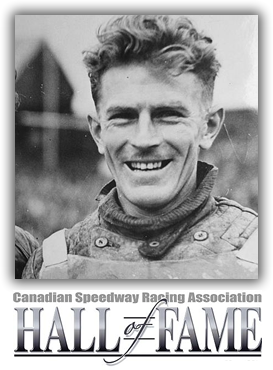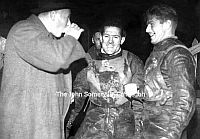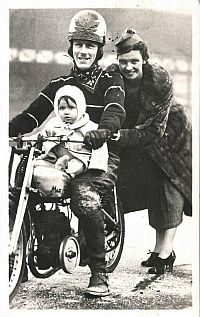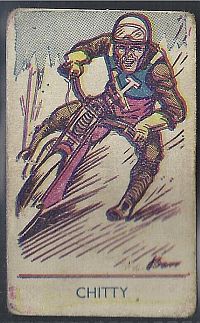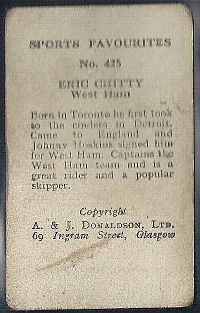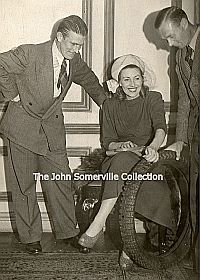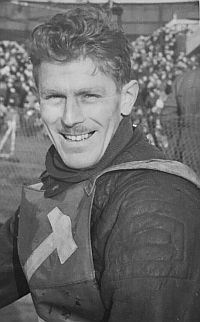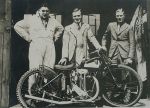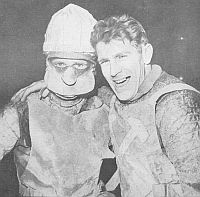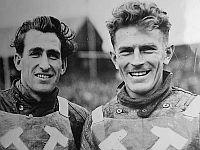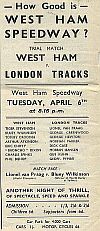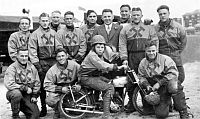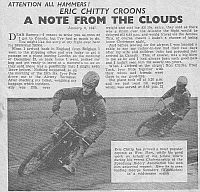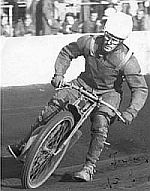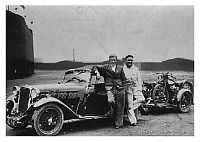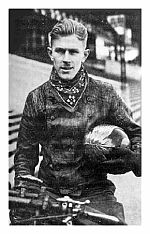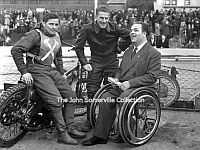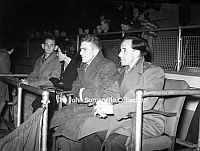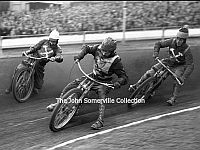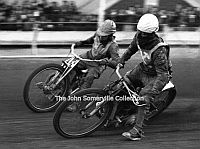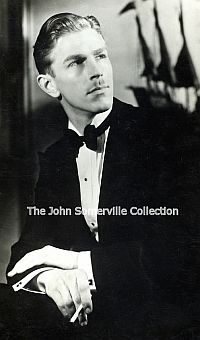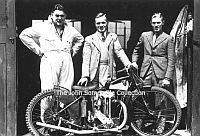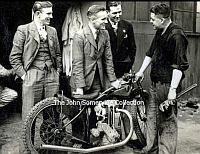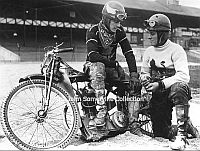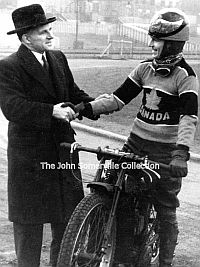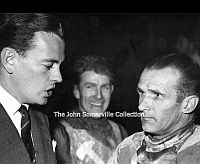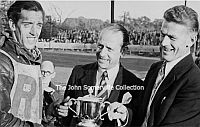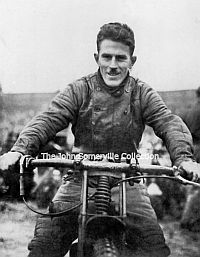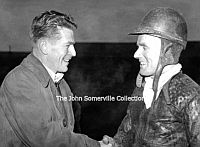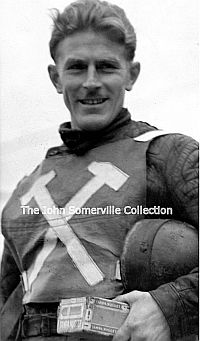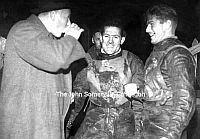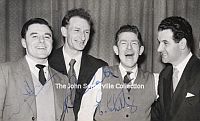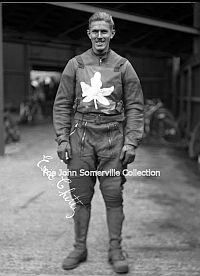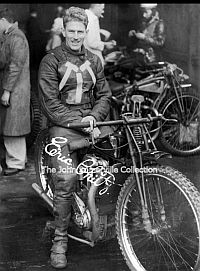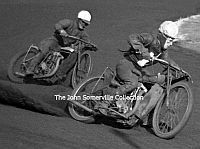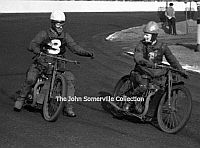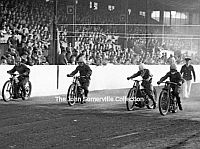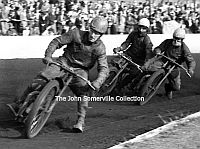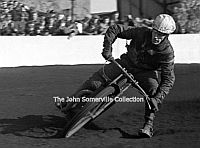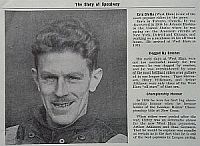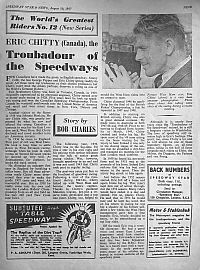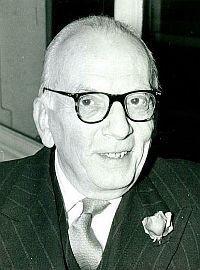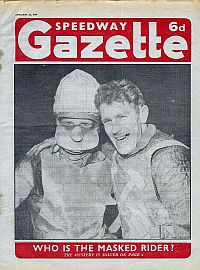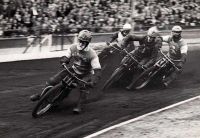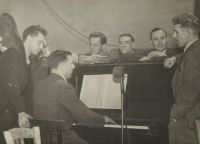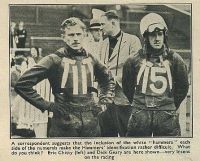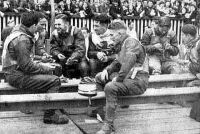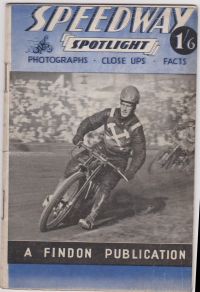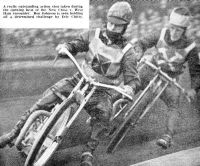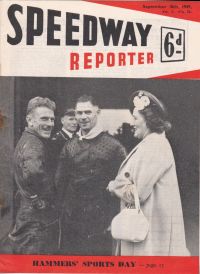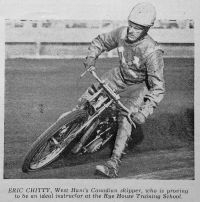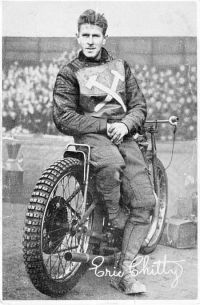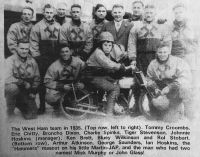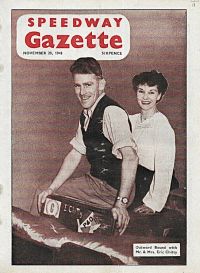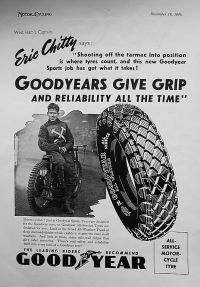One of the best known Canadian Speedway racers in England was Eric Chitty.
Eric Stevenson Chitty was born in Toronto on the 28th of April in 1909, to English parents who had emigrated to Canada.
His father was born in Hammersmith, London not far from where Eric would ply his trade as a Speedway rider.
His love affair with motorbikes started at age 15 when he borrowed an old belt driven Enfield from a friend of the family, which he rode, took to pieces and re-assembled. Eventually Eric wanted his own bike and saved up $75 to buy a brand new Indian motorcycle.
To be able to save up this princely sum he not only gave up entertainment but his girlfriend also as she lived a $1 fare away from where he lived! Just turned 18 years old, Eric paid up and bought a new Indian motorcycle.
As fate would have it the owner told Eric about a race meeting in Newmarket on a half-mile dirt track and that he may want to "have a go". He proceeded to win his class riding what was called the foot forward style, which he adopted from the start rather than leg trailing which was practiced by many riders of the day. And as for headgear well he had nothing in the way of protection except a hat! Eric raced many forms of motorcycle racing and in 1929 he traded the Indian for a 350cc AJS.
He had his first serious crash that year riding at the Exhibition track in Toronto when a fellow competitor knocked his front wheel clean out of the forks. The inevitable flight over the handlebars flung him into a 4" wooden post, which left him in hospital for seven days with a badly swollen neck.
In 1930 he bought a Rudge Motorcycle and came second in the Canadian 10 and 25-mile championships on the ½ mile and the Castrol trophy for best all round Canadian Amateur motorcyclist in Canada. Also that year he persuaded a young lady by the name of Eugenie Stead of Toronto to become his passenger in sidecar events. (It was not common to have women compete in events like this in 1930. And even less to win at a speed of 75 mph!)
It wasn't long before she became Mrs. Eric Chitty.
Eric was an electrical engineer by trade and rode speedway whenever he could both in Canada and in the northern USA. In the early 30's the slump hit Canada and Eric started life as a professional motorcycle rider doing speedway circuits of Toronto, Chicago, Indiana, Milwaukee and Detroit. In one outing Eric found himself in a major crash landing under all four bikes the rear chain of one of these bikes tasking the tops of two of his fingers on his right hand. Another stay in hospital followed, as he was unconscious for four days.
On returning to Toronto he entered the ¼ mile Speedway Championship at the old Ulster Stadium. Even so the hand had not healed and he had difficulty letting go the handlebars after a race. He scored maximum points beating such stars of the time Jimmy Gibb, Goldy Restall,George Pepper etc. who all rode for British clubs.
During this racing period Eric was in and out of hospital twelve times, but luckily he healed fast!
He retired in 1931 due to illness, but returned in 1934 to become the Canadian Speedway Champion. That same year, he had a chance meeting with the "father of speedway" Johnny Hoskins in Toronto and was offered a contract in England. In 1935, Eric tried his luck on the Eastern US speedway circuit ran by "Sprouts" Elder This lead to yet another crash and a trip to hospital. While leading a race at Philadelphia he over slid and another rider slammed right into his chest. Rushed to hospital with internal injuries first diagnosis was that he would not make it but luckily he rallied and was out of hospital in a few days against doctors orders with broken ribs and an unknown internal injury.
Now with a child and low on money Eric reconsidered his career as a speedway rider.
Remembering the offer from Johnny Hoskins Eric made the decision to try his luck in old Blighty! Eric was sent a one-way fare and was met in England by Johnny and a flock of newspapermen who Johnny had brought along to see his new signing and according to Johnny who was going to take England by storm!
Eric had the equivalent to $1 in his pocket. Not much even in those days!
Whisked off to his lodgings he met with the other West Ham promoter who produced a 100 pounds advance to get over his temporary difficulties!
Now all he had to worry about was riding strange tracks in a strange country and be the champion all the reporters had been told about!
The first two meetings were a disaster, as he could not do a thing right. In the third meeting things went even worse as he fell in front of a rider resulting in a broken kneecap!
Now he had to ride on with the injury as the 100 pounds was going fast and the knee the size of a balloon things, went from bad to worse.
Out of the team he went and in desperation he took his trade to the lower speedway divisions then called the Provincial speedways.
Things turned around immediately as Eric found his old form and started to break track records.
West Ham recalled him back to ride for his parent team.
Eric supplemented his earnings with singing engagements as he was known as a crooner. he was also a singer, writer and businessman. Eric used to sing to the fans during the half time interval. He apparently had a good voice and the event was billed as a "Ditty from Chitty." In 1948, he wrote a column for the Speedway Gazette Newspaper. Eric had a company called Eric "Ricky" Chitty Ltd with a shop located at Plaistow in Barking Road about a mile from the Custom House Stadium. It sold everything from children's toy bikes up to the real thing, speedway bikes; they also sold racing leathers and had a motorcycle repair service.
He actually made a few records, the most famous being "When I Grew Too Old To Dream". During his time at West Ham, the crowd at Wembley sang "Eric Chitty may be fine, but give me a Kitchen every time" regarding their team captain Bill Kitchen to get Eric wound up! A recording contract followed and he made several recordings. Some of the money from this endeavor went to the fledgling Speedway Riders Association of which Eric was a founding member.
Improvements came in the next two years but also more niggling injuries.
In 1937, he reached the World finals and finished tied for 8th place but also managed to break both arms.
Eric had spent some of his hard won money and invested it in a cycle business in London but had came home for the winter to be with his family.
News came from England that the business was failing.
In 1938 Eric needed every penny he could earn to settle his business affairs.
At first all was well as he won the London Riders' Championship at New Cross then the injuries kicked in. A severe concussion, which caused him to be on the danger list for a while, a fracture wrist, two chipped shoulder blades and another broken wrist.
In 1939 what else could go wrong. All was well as Eric was having his best season ever and qualified for the 1939 World Final, which was canceled by Adolf Hitler and the start of WW2.
A stint as a war reserve policeman was followed by a stint in the shipyards. Off to war then as he passed all the interviews and medicals for a fighter pilot only to be washed out for being 2 months too old! Back to war production running a factory building aircraft.
The desire to fight for his country had him applying for the navy and a commission only to be denied as being too valuable to the war effort in the factory.
Somehow during the war period he managed to race at Belle Vue in Manchester the only track that ran all through the war. Winning the unofficial British Individual Championship in 1940, 41 and 42. He won the Belle Vue Grand Prix, the Northern Championship & the Hundred Guineas Trophy all in 1942. He won the all English Best Pairs Championship in 1941 with Ron Johnson and 1943 with Fred Tuck. In 1944 he won the National Trophy and also in 1944 he won the British Empire Best Pairs with Ron Clark.
In the winter of 1945-46 he toured Germany as the captain of the ENSA Speedway team. Although called a team, it was more of a Speedway Circus with solo events being put on in various parts of occupied Germany and challenges against the local army dispatch riders, many of which were Speedway riders before the war.
ENSA was an organization that put on shows for service personnel.
In 1946 all the riders were put in a pool and once again he found himself back at West Ham as captain of the team. There he consistently piled up the points over the next few years.
Ever the entertainer his promoter Jonny Hoskins always came up with novel ideas and had Eric race against a Cheetah at West Ham.
In 1948, he traveled to Australia where he suffered yet another injury, a broken leg which kept him out the first half of the 1948 season. This injury caused a drop in form for the West Ham skipper. He soldiered on racing for his team.
Eric retired in 1952, in his younger days he wanted to be a jockey and just loved riding, he took his daughter out one weekend and got on a horse called "Skylon". All was well until the horse reared, slipped and came down with his left leg underneath it. Result -the same leg broken that he broke in Australia and that was that.
He never was given the chance to get back in form, even if he wanted to and one night in the third lap he just veered off into the pits and said that was that, it was quite the night bikes and all equipment were sold next day and his career came to a stop.
Eric Chitty rode for West Ham from 1936-1939 and 1946-1951.
In the all time West Ham top twenty riders poll held when West Ham closed in 1972, he was voted No 7.
In 1985 he came back to Toronto to live and still rode a motorcycle to work as weather permitted.
He was a Canadian snowbird during the winter.
Sadly he was taken ill in 1990 and passed away. Read Robert J. Roger's Article - Click Here
Eric Chitty Mini-Book - Click Here
Canadian Motorcycle Hall of Fame - Click Here

| 
